
How to Find Probability of Complement Events YouTube
9.2: Union, Intersection, and Complement. Commonly sets interact. For example, you and a new roommate decide to have a house party, and you both invite your circle of friends. At this party, two sets are being combined, though it might turn out that there are some friends that were in both sets.

What Are Complementary Events In Probability Statistics, Definition And Formula YouTube
Probability of an event happening = Number of ways it can happen Total number of outcomes Example: the chances of rolling a "4" with a die Number of ways it can happen: 1 (there is only 1 face with a "4" on it) Total number of outcomes: 6 (there are 6 faces altogether) So the probability = 1 6 The probability of an event is shown using "P":
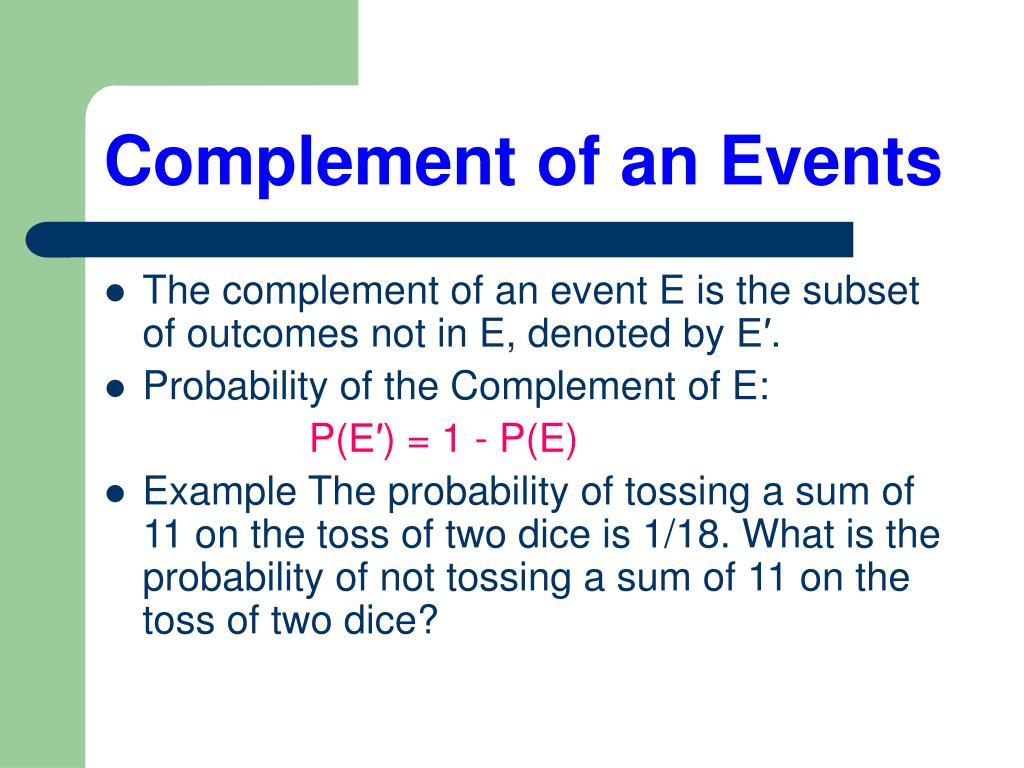
PPT Section 11.4 Addition and Complement Rule PowerPoint Presentation ID256590
What is the probability that a customer spends at most $100 per transaction? Solution: Spending at most $100 ($100 or less) per transaction is the complement of spending more than $100 per transaction.

Question Video Determining the Probability of Complement of a Given Event Nagwa
Rather than listing all the possibilities, we can use the Complement Rule. Because we have already found the probability of the complement of this event, we can simply subtract that probability from 1 to find the probability that the sum of the numbers rolled is greater than 3. P (E′)= 1−P (E) =1− 1 12 = 11 12 P ( E ′) = 1 − P ( E.
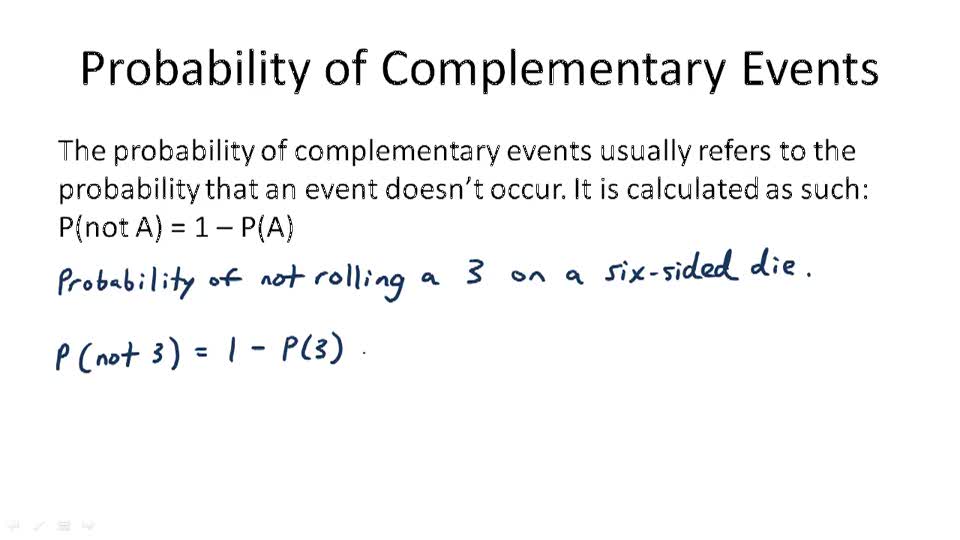
Probability of Complementary Events Overview ( Video ) Probability CK12 Foundation
The complement of the event A is denoted by AC. The complement of A is the set of all elements in the universal set, or sample space S, that are not elements of the set A . The complement rule is expressed by the following equation: P ( AC) = 1 - P ( A ) Here we see that the probability of an event and the probability of its complement must.
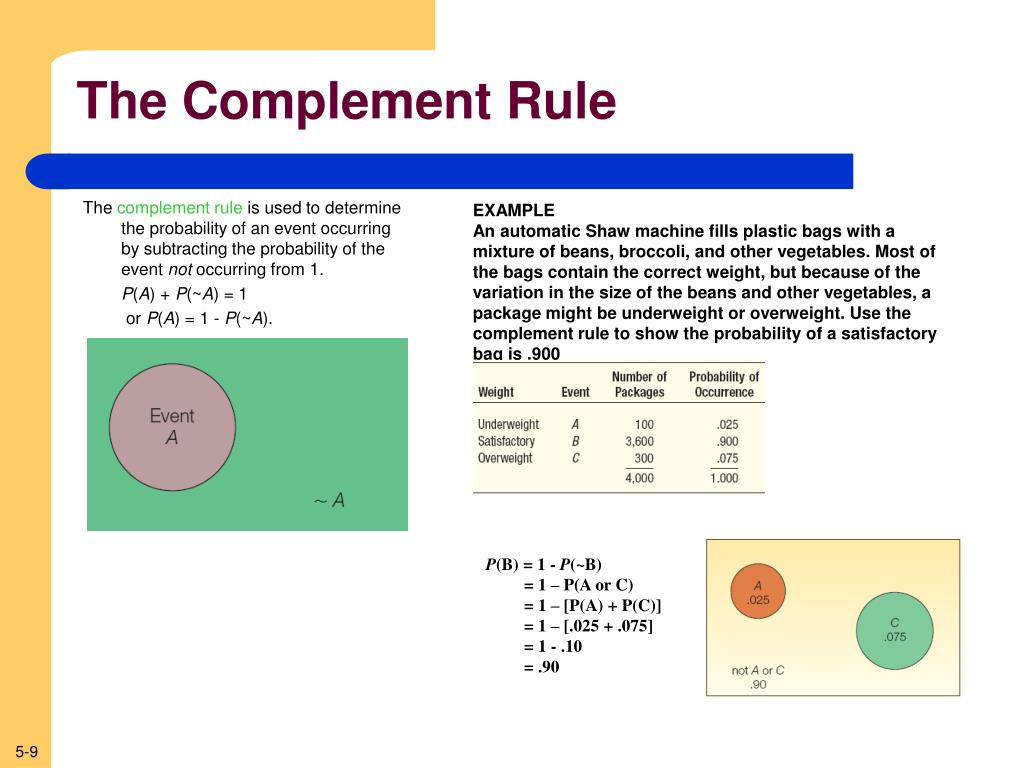
PPT A Survey of Probability Concepts PowerPoint Presentation ID314183
We can use the probability of the complement to find the probability of the event by subtracting it from one. This trick is often used when calculating the probability of multiple events. The Probability of the Complement of an Event This video provides two basic examples of how to find the complement of an event.

Probability of Complementary Events & Sample Space YouTube
1. Suppose you know that the probability of getting the flu this winter is 0.43. What is the probability that you will not get the flu? Let the event A be getting the flu this winter. We are given P ( A) = 0.43. The event not getting the flu is A ′. Thus, P ( A ′) = 1 − P ( A) = 1 − 0.43 = 0.57. 2. Two coins are tossed simultaneously.

Ex Find the Probability of a Complement Using a Table YouTube
The complement rule is stated as "the sum of the probability of an event and the probability of its complement is equal to 1," as expressed by the following equation: P ( AC) = 1 - P ( A ) The following example will show how to use the complement rule. It will become evident that this theorem will both speed up and simplify probability.
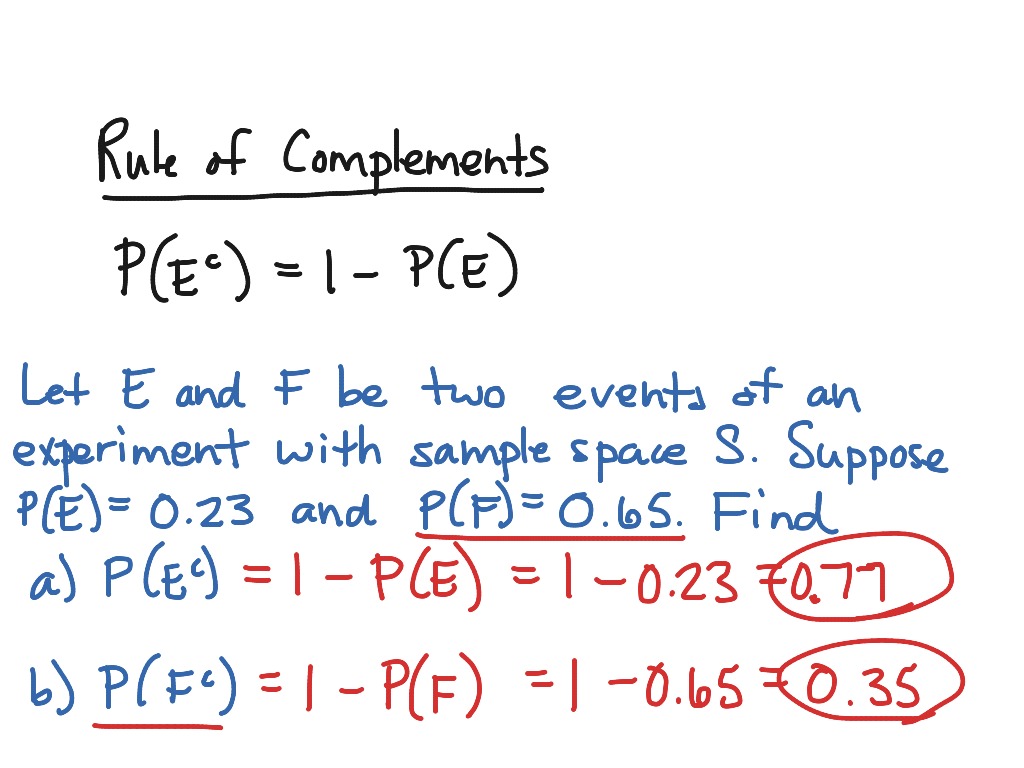
Rule of Complements in Probability Math ShowMe
The probability of an event that is a complement or union of events of known probability can be computed using formulas. 5.2: Complements, Intersections, and Unions is shared under a CC BY-NC-SA license and was authored, remixed, and/or curated by LibreTexts.

Complement Rule (Probability) YouTube
An example of an "at most" event is supposing you want to find the probability of rolling a die and getting at most a 4. That means that you want to get less than or equal to a 4 on the die, a 1, 2, 3, or 4. The reason to use the complement is that sometimes it is easier to find the probability of the complement and then subtract from 1.

PPT Chapter 4 Probability PowerPoint Presentation, free download ID5484219
The complement rule works off of the idea that two parts make a whole. In probability, the "whole" refers to all possible outcomes. I find it's easiest to think of this as being 100%, which we know as a decimal value is simply 1. Thus, the sum of the probabilities of all possible outcomes must equal 1. There are a few situations where this rule.

Proof for the Probability of a Complement YouTube
The reason to use the complement is that sometimes it is easier to find the probability of the complement and then subtract from 1. We will use this idea again in section 3.5. This page titled 3.3: Complement Rule is shared under a CC BY-SA 4.0 license and was authored,.

Probability The Rule of Complementary Events YouTube
The complement of an event is a list of all the ways that event doesn't happen. So, it's the list of all outcomes of an experiment that do not form part of that event. Let's look at some examples. Examples If the event is { Green }, the complement is { Red }.

Prove that Probability of the Complement of A is One Minus the Probability of A YouTube
When an event is described to you as something that could possibly happen, the complement of that event is every other possible thing that could happen. There is a box with red, blue, and green balls. A ball is drawn at random from the box. Let R R be the event that a red ball is drawn. Describe R^c Rc.
:max_bytes(150000):strip_icc()/complement-56a8fa9a5f9b58b7d0f6e9e7.jpg)
How to Prove the Complement Rule in Probability
Complement of an Event. The complement of an event E E is the event " E E doesn't happen". The notation E¯ E ¯ is used for the complement of event E E. We can compute the probability of the complement using P(E¯) = 1 − P(E) P ( E ¯) = 1 − P ( E) Notice also that P(E) = 1 − P(E¯) P ( E) = 1 − P ( E ¯) Example 1.
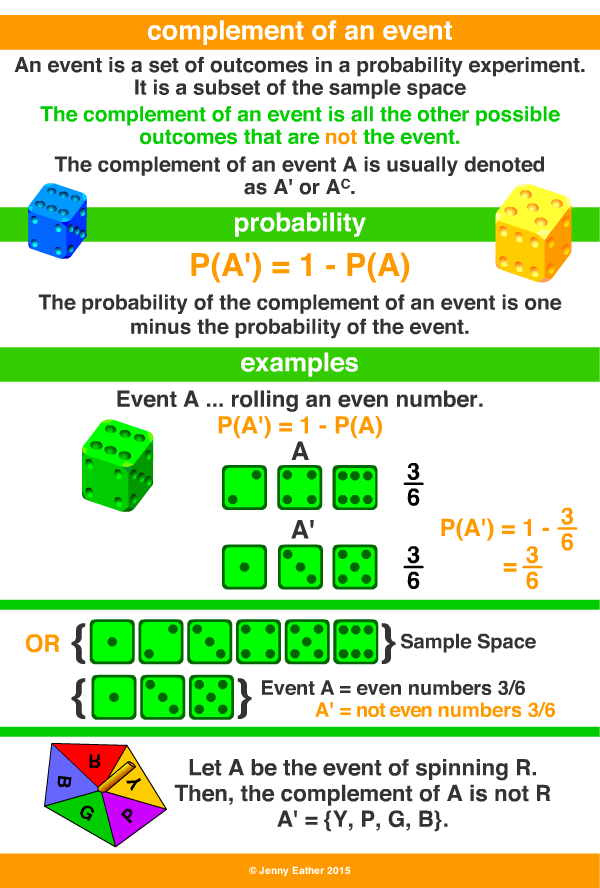
complement of an event A Maths Dictionary for Kids Quick Reference by Jenny Eather
Definition of Complement (probability) more. The Complement of an event is all outcomes that are not the event. Example: For dice, when the event is {5, 6} the complement is {1, 2, 3, 4} The symbol is a little dash in the top-right corner Example: A' = {1, 2, 3, 4} Together the event and its complement make all possible outcomes.